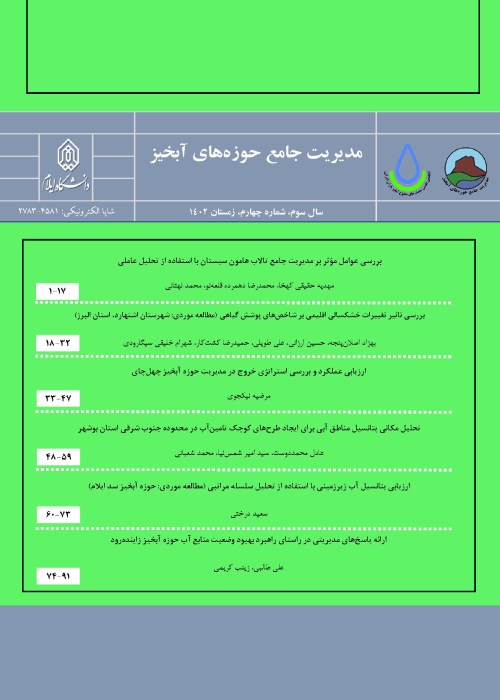Evaluation of the efficiency of REMO regional climate model and CanESM2 general circulation model in predicting climatic parameters (Case study: Isfahan province)
The increase in greenhouse gases in recent decades and the resulting increase in temperature have upset the balance of the Earth's climate system and caused widespread climate change in most parts of the world. According to the definition of the Intergovernmental Panel on Climate Change (IPCC) (2013), climate change is a change in the state of a climate in which its mean or changeable characteristics change for decades or longer. Therefore, forecasting climate variables in the future is necessary to consider measures to reduce the effects of climate change. Climate models are good tools for assessing the climate in the future. These models simulate climatic parameters in the future by different scenarios of radiation induction. Selecting an appropriate climate model is essential for predicting and simulating climate data in the future, as well as evaluating changes in climate parameters in the future. An overview of studies conducted on the application of climate change models in the country indicates that in most studies, the application of atmospheric circulation models has been studied and regional models have been evaluated less. Therefore, in this study, two models of general circulation of atmosphere and region in Isfahan province are compared.
Isfahan province, with an area of 107018 square kilometers, is located between 30 degrees and 43 minutes to 34 degrees and 37 minutes north latitude of the equator and 49 degrees and 38 minutes to 55 degrees and 32 minutes east longitude of the Greenwich meridian. The climate of Isfahan province is generally temperate and dry. In this research, daily observational data including rainfall, average temperature and average wind speed from the Meteorological Organization, data predicted by REMO model in the base period 1991-2005 and the future period 2020-2100 for the parameters of rainfall, average temperature and wind speed from the base CORDEX data and three types of inputs were used to model climate variables by CanESM2 model. These inputs include daily precipitation data, mean temperature and mean wind speed of the synoptic station, open atmosphere analysis data (NCEP) and CanESM2 model data. To evaluate the efficiency of the models in the study area, the observational data and the data predicted by the models in the common statistical period by the statistical criteria of Percentage coefficient (PBIAS), Nash-Sutcliffe coefficient (NSE), standard ratio root (RSR), explanation coefficient (R2) and square error (RMSE) were assessed. Also, in order to better evaluate the performance of the models, the data simulated by the models were compared with the observational data by months.
The results of this study for the REMO regional climate model showed that this model is not suitable for simulating the rainfall parameter in Isfahan, Airport, Kashan and Golpayegan stations, nor is it suitable for simulating the average temperature parameter in Isfahan, Golpayegan, Nain and Kashan stations. In these stations, on average, the values simulated by the model for the precipitation parameter are more than the observational values and for the average temperature parameter are less than the observational values. In other studied stations, the values simulated by the model for rainfall parameters and average temperature have an acceptable agreement with the observational data. Also, the correlation of the simulated values of the model with the observational data for the wind parameter indicates that this model is not suitable for predicting wind data in the study area and the values simulated by the model are on average higher than the observational data in the period. The results of the CanESM2 atmospheric circulation model showed that the SDSM model has a high efficiency for modeling and exponential microscale in the study area. The results also showed that this model has a high efficiency for simulating the parameters of average temperature and wind speed relative to rainfall in the study area, which can be due to the presence of zero values in the data series. The results of rainfall parameter statistical criteria showed that the CanESM2 model in Daran, Isfahan, Khor and Biabank, Nain and Natanz stations is suitable for simulating rainfall in the future. Also, the results of the statistical criteria and simulated data of the model in the joint period for temperature and wind parameters showed high agreement with the observational data.
Climate models are appropriate tools for assessing the climate in the future. In this study, the efficiency of REMO regional climate models and the general CanESM2 atmospheric model were investigated. The results showed that the REMO climate model does not have the appropriate efficiency to simulate rainfall, average and wind speed in the study area, but CanESM climate model has high efficiency to simulate average and wind speed in the region. It can therefore be used as a suitable model for forecasting future climate in the study area.
- حق عضویت دریافتی صرف حمایت از نشریات عضو و نگهداری، تکمیل و توسعه مگیران میشود.
- پرداخت حق اشتراک و دانلود مقالات اجازه بازنشر آن در سایر رسانههای چاپی و دیجیتال را به کاربر نمیدهد.


